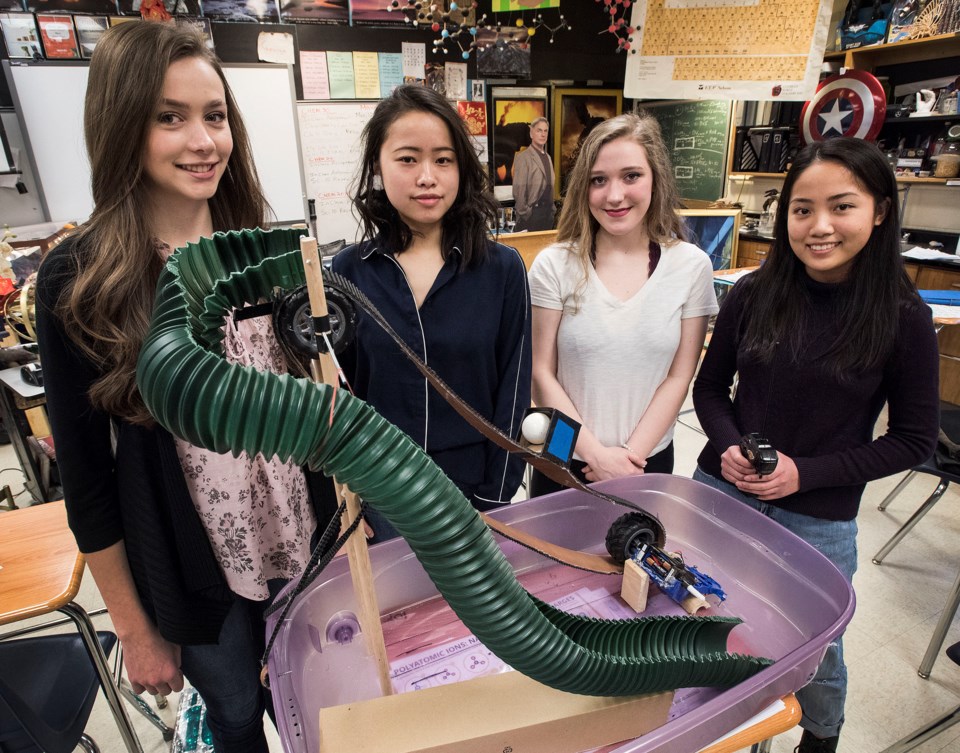St. Albert students will take eggs for a wild theme-park ride today as they go for gold at the Edmonton Science Olympics.
About 650 Edmonton-area youths from grades 1 to 12 are at the University of Alberta’s Butterdome today for the 2018 Edmonton Science Olympics.
Organized by the Association of Professional Engineers and Geoscientists of Alberta (APEGA), this annual event has students use their science and engineering skills to complete a number of hands-on challenges.
The games are meant to get students interested in engineering and science careers, and help them develop creativity, communication and teamwork skills, said Natalie Hervieux, outreach co-ordinator with APEGA.
“It’s important to make kids realize that science and engineering can be fun.”
Winning teams will receive certificates and 3D-printed trophies, Hervieux said.
St. Albert Olympians
Science Olympians compete in teams of five in one of four age classes, with different challenges for different age groups. Each team will have had a month or two to complete an in-class project to present at the Olympics, and will also have to complete one to three mystery tasks on competition day. Past mystery events have had students build oilsands filters, elastic-powered egg transports, and bridges made out of toilet paper.St. Albert and Sturgeon County will have a strong presence at today’s games, with Elmer S. Gish, Robert Rundle, Father Jan, Ronald Harvey, G.H. Primeau, Sir George Simpson, Paul Kane and Sturgeon Composite all fielding teams.
Teacher Melissa Zawaduk said she has been taking students to Science Olympics for about 20 years, and this year had two teams from Elmer S. Gish. Her students have spent the last few months designing a hypothetical cybernetic glove for people without the sense of touch and goggles with interchangeable coloured lenses that they’ll use to find secret messages.
Zawaduk said Science Olympics were super-popular at Gish. She usually gets 60 to 70 applicants for teams, and typically has to draw names out of a hat. Those that make the team are seen as celebrities.
“We’ve seen a huge surge in interest in science and technology,” she said, and the Olympics give students a chance to explore their passions and see where science can take them in future grades.
“They get to see the projects from all different age levels and see how science can be applied as a way to solve problems.”
Paul Kane’s two squads were scrambling to finish their classroom projects Wednesday in coach Michael Ng’s room. Each had to build and design a safe, realistic, and fun amusement park ride with an egg as a test pilot and calculate the physics involved in it.
Yani Kwok said she and the rest of Team Au (Gold) Diggers based their ride on Disneyland’s Splash Mountain. Using some green flexi-pipe, a tub, and a salvaged remote-control car, their ride pulls passengers in a log-like structure along a conveyor belt to the top of a curved slide. Once there, riders hurtle down the slide to splash into the water-filled tub.
Teammate Katrina Sha said the team still had to decorate the ride to make it look more authentic, and was a bit concerned that the egg could get stuck at the top of the conveyor belt. Still, she was confident in the ride’s fun-factor.
“I think it’ll be a blast. The egg will have a lot of fun!”
Jacob Cole was working on Team Two’s Scrambler – a cross between a centrifuge and a trebuchet that spins passengers around at dizzying speed. The ride is designed to slow to a stop so that it doesn’t hurl passengers over the horizon, and comes equipped with a padded compartment and safety straps.
Cole, who planned to get into engineering, said he’s participated in Science Olympics for many years.
“It’s just fun. You get to apply science in a meaningful way.”
The Science Olympics run from 8:30 a.m. to 4 p.m. today (Feb. 24) at the U of A’s Butterdome.




